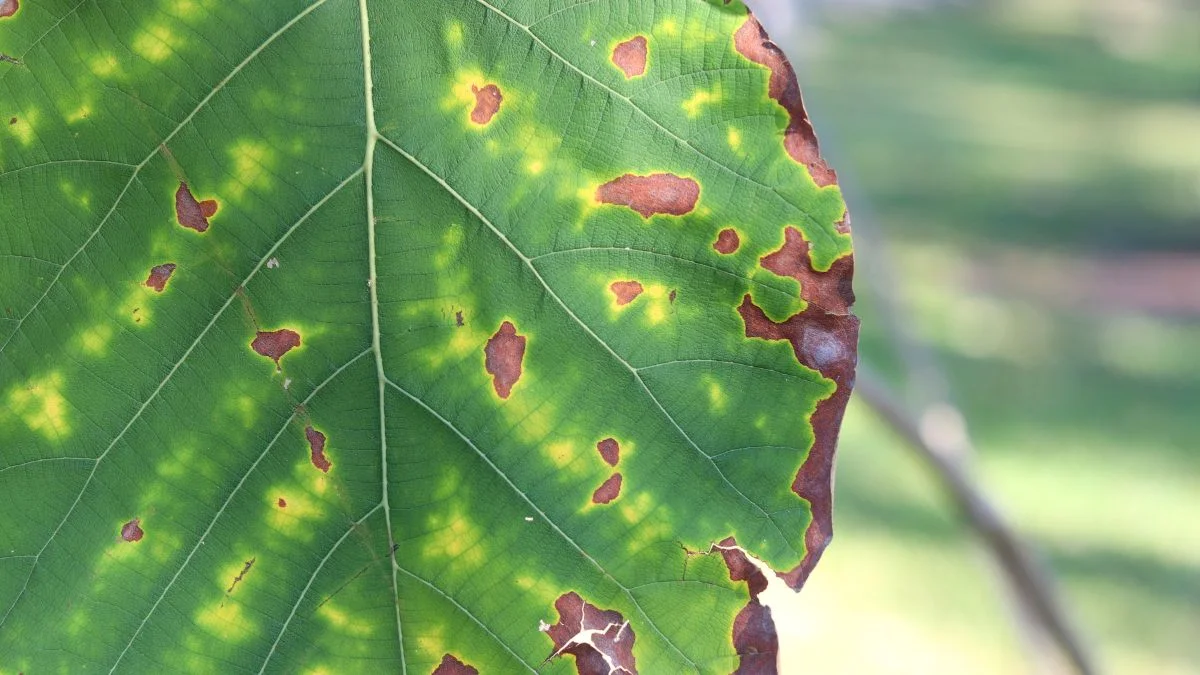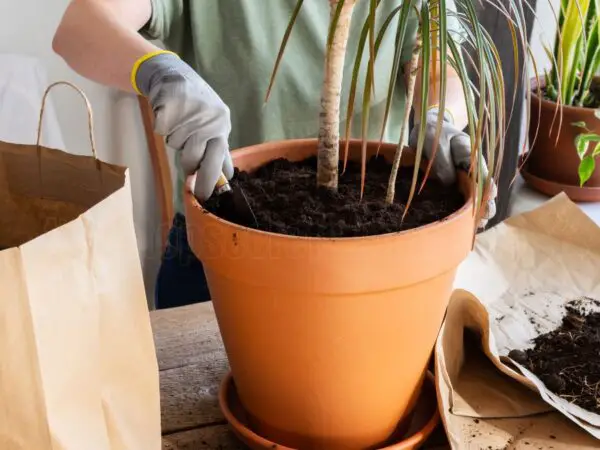Discovering brown patches or black spots on the leaves of your houseplants can be alarming due to fungal diseases like anthracnose. These unsightly blemishes, such as black spots and blight, often indicate underlying issues that need attention and causes brown leaves. From nutrient deficiencies to pests like spider mites or diseases such as blight, various factors can cause these troubling discolorations. Understanding the root cause is crucial to restoring your plant's health and vitality. By gaining knowledge about these issues, you can take proactive steps to ensure your plants thrive and remain vibrant.
Key Takeaways
- Identify the Cause: Examine your plants closely to determine the root cause of brown spots on leaves.
- Maintain Plant Health: Ensure proper watering, sunlight, and nutrition to prevent brown spots from developing.
- Prune Infected Areas: Trim affected leaves and branches to stop the spread of brown spots.
- Use Fungicides: Consider using fungicides to treat severe cases of brown spots on plant leaves.
- Monitor Regularly: Keep a close eye on your plants for any signs of leaf spot diseases and take prompt action.
- Seek Professional Advice: When in doubt, consult with a gardening expert for advanced care tips tailored to your specific plant species.
Understanding Brown Spots
Common Causes
Brown patches on plant leaves commonly stem from fungal infections which thrive in humid conditions. These infections often manifest as irregularly shaped spots. bacterial infections can cause brown patches, leading to dark lesions with defined edges. Nutrient deficiencies, such as lack of nitrogen or potassium, can also result in brown spots due to improper plant growth. Environmental stressors like extreme temperatures or inadequate sunlight further contribute to the development of brown patches.
Types of Brown Spots
Various types of brown spots can afflict plant leaves, each indicating distinct issues. Burn-like marks typically arise from sunburn or chemical exposure, presenting as darkened areas on the leaf surface. On the other hand, dry edges with yellow halos suggest a fungal infection, characterized by browning at the leaf margins accompanied by yellow rings. Tiny yellowing spots may indicate a nutrient deficiency or pest infestation, signifying localized damage that affects overall plant health.
Impact on Plant Health
Brown patches not only mar the appearance of plants but also pose significant threats to their vitality. These patches weaken plants by impeding photosynthesis and nutrient absorption, diminishing their ability to thrive. Weakening plants are more susceptible to pest attacks and diseases, jeopardizing their long-term health. Addressing brown patches promptly is crucial to prevent further damage and maintain optimal plant health.
Identifying Brown Spots
Leaf Spot Diseases
Leaf spot diseases are fungal or bacterial infections that can result in the formation of brown patches on plant leaves. These diseases thrive in warm, moist environments, leading to visible symptoms on the foliage. Common examples include anthracnose and Septoria leaf spot, causing brown spots with irregular shapes.
These diseases typically manifest as small, round lesions that gradually enlarge and merge, forming larger brown areas on the leaves. They may exhibit dark borders and a yellow halo surrounding the affected area. By recognizing these characteristics, gardeners can swiftly identify and address leaf spot diseases.
Burn-Like Marks
Burn-like marks on plant leaves resemble actual burns with their browning edges and crispy texture. These marks can be caused by various factors, including excessive exposure to sunlight leading to sunburn or chemical exposure from fertilizers or pesticides. Differentiating burn-like marks from other brown spots involves observing the distinct patterns and textures.
To distinguish burn-like marks from other types of brown spots, look for signs of uniform browning across the leaf surface or specific patterns that align with sun exposure angles. Proper identification is crucial for implementing appropriate remedies and preventing further damage to the plants.
Dry Edges and Yellow Halos
The presence of dry edges and yellow halos around brown patches on plant leaves indicates underlying issues such as nutrient deficiencies or environmental stressors. Nutrient deficiencies like nitrogen or potassium can lead to yellowing halos, while environmental stress factors like improper watering or extreme temperatures can cause dry edges.
Addressing dry edges and yellow halos effectively involves conducting soil tests to determine nutrient levels and adjusting fertilization accordingly. Maintaining consistent watering practices and providing adequate protection from extreme weather conditions can help alleviate these symptoms and promote overall plant health.
Preventing Brown Spots
Proper Watering Techniques
Proper watering is crucial to prevent brown patches on plant leaves. Avoid overwatering by allowing the soil to dry between watering sessions. Ensure adequate hydration without drowning the roots.
Adequate Sunlight Exposure Sunlight exposure plays a vital role in preventing brown spots on plant leaves. Different plants require varying amounts of sunlight for optimal growth. Position plants strategically to receive adequate sunlight based on their species' needs.
Nutrient Management Maintaining proper nutrient levels is key to preventing brown patches on leaves. Essential nutrients like nitrogen, potassium, and magnesium are essential for healthy foliage. Regularly fertilize plants to ensure they receive the necessary nutrients for vibrant growth.
Treating Brown Spots
Natural Remedies
When dealing with brown patches on plant leaves, natural remedies can be effective in combating fungal and bacterial infections. Organic solutions like neem oil and baking soda have shown promising results in treating these issues. Neem oil acts as a natural fungicide, while baking soda helps to control fungal growth on leaves.
e other natural ingredients that can help alleviate brown patches include garlic, cinnamon, and chamomile tea. These ingredients possess antifungal properties that can aid in preventing further spread of infections on plant leaves.
Chemical Treatments
In cases where natural remedies may not suffice, chemical treatments play a crucial role in addressing brown spots on plant leaves. Fungicides and bactericides are commonly used to control fungal and bacterial infections effectively. These chemical solutions target the pathogens causing the brown patches, aiding in plant recovery.
When applying chemical treatments, it is essential to follow guidelines for safe and effective usage. Proper dilution ratios, application frequencies, and protective measures should be adhered to minimize any potential harm to the plants or the environment.
Pruning Infected Areas
To prevent the spread of brown patches on plant leaves, pruning infected areas is vital. Removing affected plant parts helps contain the infection and promotes healthy growth. Proper pruning techniques involve cutting at an angle just above a leaf node to encourage new growth.
Timing is crucial when it comes to pruning to manage brown patches effectively. It is recommended to prune during the plant's dormant season or when symptoms first appear. Regular inspection of plants can help identify infected areas early for prompt pruning.
Managing Leaf Spot Diseases
Regular Monitoring
Regular monitoring is crucial to detect brown patches early, preventing extensive damage to plant health. By observing plants frequently, you can identify any signs of leaf spot diseases promptly. This proactive approach allows for timely intervention, ensuring the overall well-being of your plants.
Establishing a monitoring routine involves inspecting leaves for any unusual discoloration or spots regularly. By dedicating time to observe your plants, you can catch any issues early on and take necessary actions to address them effectively. This practice not only helps in preventing further spread of diseases but also promotes healthier plant growth.
- Monitor plants weekly
- Look for changes in leaf color or texture
- Take note of any new spots appearing on leaves
Improving Air Circulation
Enhancing air circulation around plants plays a significant role in preventing brown patches on leaves. Stagnant air creates a favorable environment for fungal and bacterial growth, leading to the development of leaf spot diseases. By allowing proper airflow, you can reduce humidity levels and minimize the risk of disease occurrence.
To improve air circulation, ensure that plants are not overcrowded and have enough space between them. Prune any dense foliage that may obstruct airflow and consider strategic placement of plants to maximize ventilation. These simple steps can significantly reduce the chances of brown patches affecting your plants.
- Prune overcrowded branches
- Space out plants adequately
- Avoid placing plants in areas with poor ventilation
Soil Health Maintenance
The quality of soil directly impacts the susceptibility of plants to brown patches on leaves. Healthy soil provides essential nutrients and supports robust plant growth, helping them resist diseases effectively. Maintaining optimal soil conditions through proper fertilization and watering practices is key to preventing leaf spot diseases.
Ensuring adequate drainage in soil helps prevent waterlogging, which can contribute to the development of fungal infections. Using organic matter such as compost enriches the soil with nutrients, promoting plant vitality and resilience against diseases like leaf spots.
- Test soil pH regularly
- Improve drainage in compacted soil
- Incorporate organic matter into soil for nutrient enrichment
Advanced Care Tips
Dealing with Wet Spots
Wet spots on plant leaves can lead to the formation of brown patches, mainly due to excessive moisture. This damp environment encourages the growth of fungi and bacteria, increasing the risk of infections. To address this issue, ensure proper drainage for potted plants and avoid overwatering. prune overcrowded foliage to improve air circulation around the leaves.
- Pros:
- Helps in preventing fungal and bacterial infections.
- Enhances overall plant health by reducing excess moisture levels.
- Cons:
- Requires regular monitoring and maintenance.
- May involve adjusting watering schedules based on plant needs.
Treating Tiny and Yellowing Spots
When dealing with tiny and yellowing spots on plant leaves, it is essential to identify the root cause behind these symptoms. Possible reasons could include nutrient deficiencies, pests, or diseases. To address this, conduct a thorough inspection to pinpoint the issue accurately. Once identified, apply targeted treatments such as fertilization or pest control measures to restore leaf health.
- Inspect the affected leaves carefully.
- Identify any pests or signs of nutrient deficiencies.
- Treat the underlying cause promptly to prevent further damage.
- Monitor the plant's progress after treatment for improvements.
Preventing White Spots
To prevent white spots from developing on plant leaves, it is crucial to maintain optimal growing conditions. Factors like humidity levels, air circulation, and sunlight exposure play a significant role in preventing these issues. practice good hygiene by regularly cleaning plant foliage and removing any debris that may harbor pests or diseases.
- Environmental factors like high humidity can contribute to white spot formation.
- Proper ventilation can help reduce moisture levels around plants.
- Regularly inspect plants for any signs of disease or pest infestation.
Final Remarks
You've now learned how to understand, identify, prevent, treat, and manage brown spots on your plants. By following the advanced care tips provided, you can ensure your plants stay healthy and vibrant. Remember, early detection and prompt action are key in maintaining your plant's well-being.
Take the knowledge you've gained here and apply it to your gardening routine. Regularly inspect your plants, implement preventive measures, and address any issues swiftly. Your plants will thank you with lush greenery and beautiful blooms. Stay proactive in caring for your garden to enjoy a thriving outdoor oasis.
Frequently Asked Questions
What causes brown patches on leaves of plants?
Brown patches on leaves are commonly caused by fungal infections, nutrient deficiencies, overwatering, or pest infestations. These factors can lead to stress in plants, resulting in the development of unsightly brown spots.
How can I identify the cause of brown spots on my plant's leaves?
Carefully examine the affected leaves for patterns, textures, and any signs of pests. Consider environmental conditions like humidity and sunlight exposure. You may need to consult with a gardening expert or use online resources for accurate identification.
What are some effective ways to prevent brown spots on plant leaves?
Maintain proper air circulation around plants, water them at the base to avoid wetting foliage, and regularly inspect for early signs of disease. Applying preventive fungicides or adjusting nutrient levels can also help in preventing brown spots.
How should I treat brown spots on my plant's leaves?
For fungal infections, remove and destroy affected leaves, and apply appropriate fungicides. Address nutrient deficiencies through fertilization. In cases of pest infestations, consider using organic or chemical treatments recommended for the specific pests.
Are there advanced care tips for managing leaf spot diseases effectively?
Implement integrated pest management strategies, rotate crops to reduce disease pressure, and practice good garden hygiene by cleaning tools and pots. Consider using resistant plant varieties and maintaining optimal growing conditions to minimize leaf spot diseases' impact.
Image Source: Paid image from CANVA




